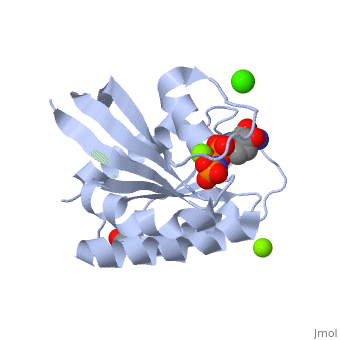Allosteric modulation of H-Ras GTPase
From Proteopedia
(Difference between revisions)
Jay Patel (Talk | contribs)
(New page: {{STRUCTURE_3k8y| PDB=3k8y | SCENE= }} '''H-Ras''' is a small monomeric GTPase protein that is found inside of cells. It helps regulate cell division in cells through signal transdu...)
Next diff →
Revision as of 00:41, 19 June 2012
| |||||||||
| 3k8y, resolution 1.30Å () | |||||||||
|---|---|---|---|---|---|---|---|---|---|
| Ligands: | , , , | ||||||||
| Gene: | HRAS, HRAS1 (Homo sapiens) | ||||||||
| Related: | 2rge, 3k9n, 3k9l | ||||||||
| |||||||||
| |||||||||
| Resources: | FirstGlance, OCA, RCSB, PDBsum | ||||||||
| Coordinates: | save as pdb, mmCIF, xml | ||||||||
H-Ras is a small monomeric GTPase protein that is found inside of cells. It helps regulate cell division in cells through signal transduction pathways such as the Ras pathway. H-Ras is also known as a molecular switch, it contains two switch regions: Switch I and Switch II. Switch I is a Thymine 35 and switch II is a Glycine 60, both of these switches depend on the phosphate group on a GTP molecule to turn “on” and “off”. In the Ras catalytic cycle, Ras is activated when it attaches to a GTP molecule turning both switch regions “on”. This pathway also involves GTPase activating protein, which hydrolyzes the GTP attached to the Ras causing the switches to turn “off”.


